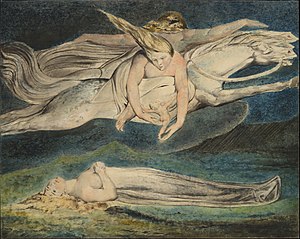| Pity | |
|---|---|
 | |
| Artist | William Blake |
| Year | 1795 |
| Type | Colour print, finished in ink and watercolour, on paper[1] |
| Dimensions | 42.5 cm × 53.9 cm (16.7 in × 21.2 in) |
| Location | Tate Gallery, London |

Pity (c. 1795) is a colour print on paper, finished in ink and watercolour, by the English artist and poet William Blake, one of the group known as the "Large Colour Prints". Along with his other works of this period, it was influenced by the Bible, Milton, and Shakespeare.[2] The work is unusual, as it is a literal illustration of a double simile from Macbeth, found in the lines:
- And pity, like a naked new-born babe,
- Striding the blast, or heaven's cherubim, horsed
- Upon the sightless couriers of the air.
- - Macbeth (1.7.21–23)[3]
Like other members of the group, it is a monotype produced by printing from a matrix consisting of paint on gessoed millboard, with each impression then finished by hand. Blake could obtain up to three impressions from a single painting by this unusual means. Three such impressions survive of Pity. A fourth, in the British Museum, was an early trial of the design from a different matrix, as it is smaller than the others.[4]
- ^ "Pity" Photograph. Encyclopædia Britannica Online. Consulted on 2 Oct. 2010.
- ^ Metropolitan Museum of Art (1980). The painterly print: Monotypes from the seventeenth to the twentieth century [exhibition], p. 84.
- ^ Bindman, David (1977). Blake as an Artist. Phaidon. p. 106.
- ^ Blake Archive.org, "The Large Color Printed Drawings of 1795 and c. 1805"